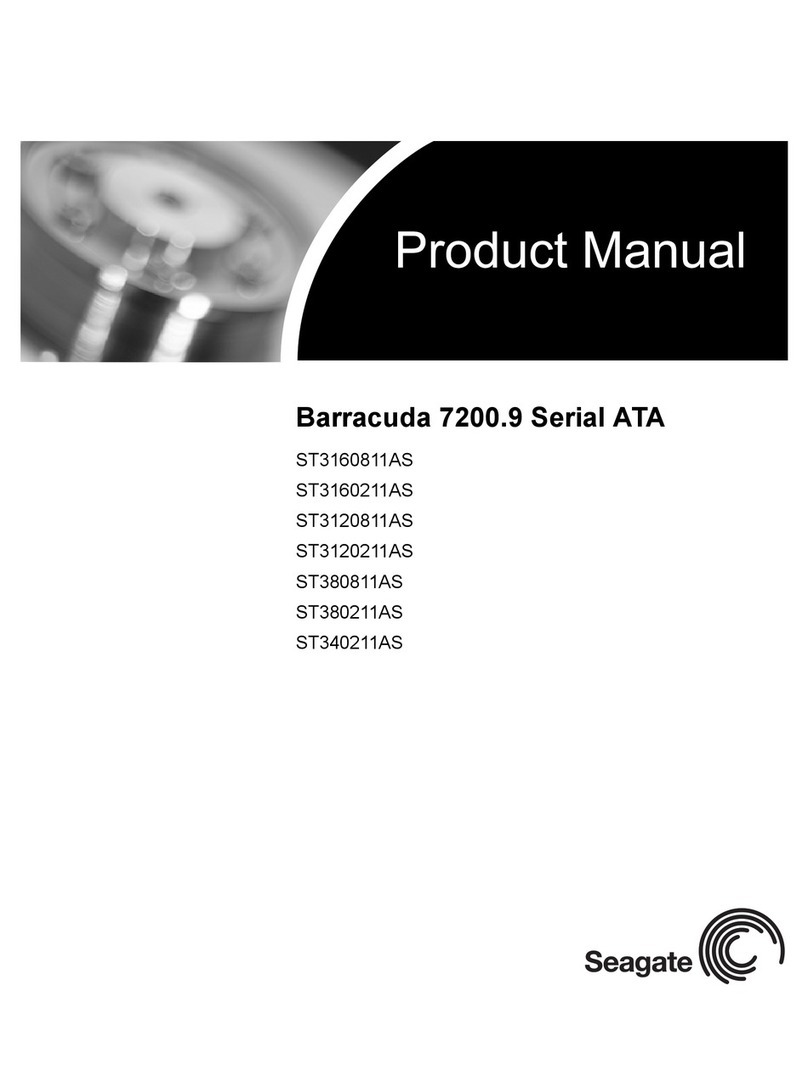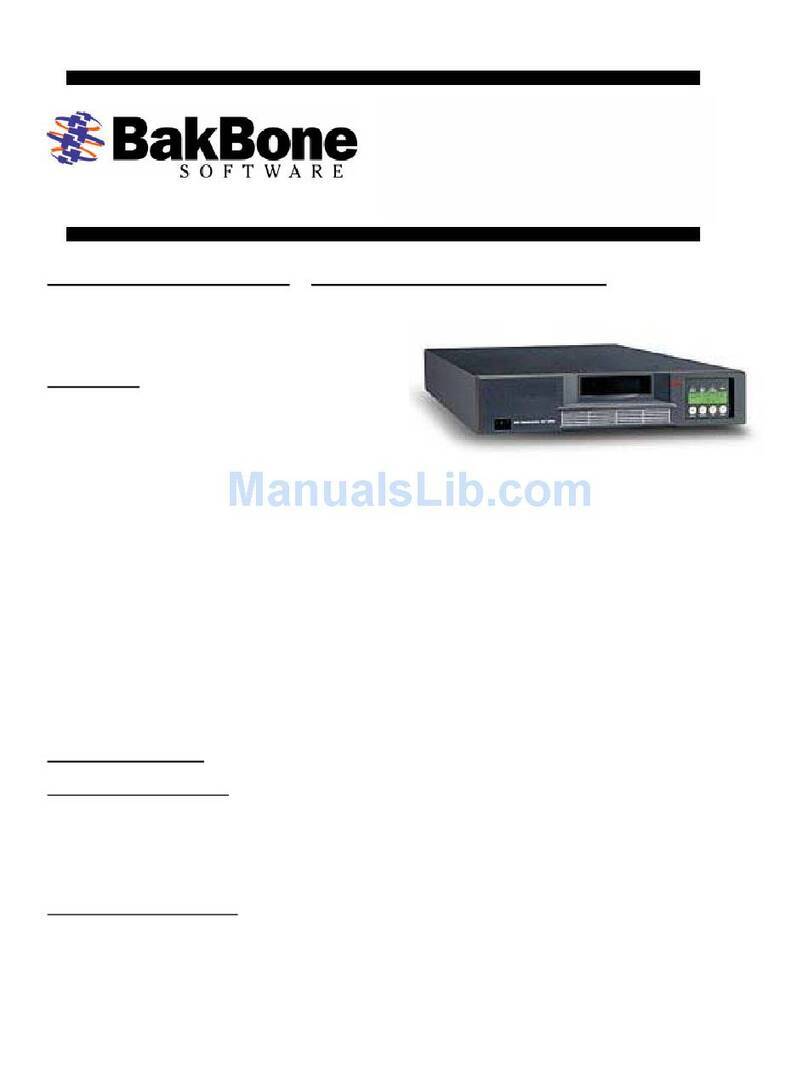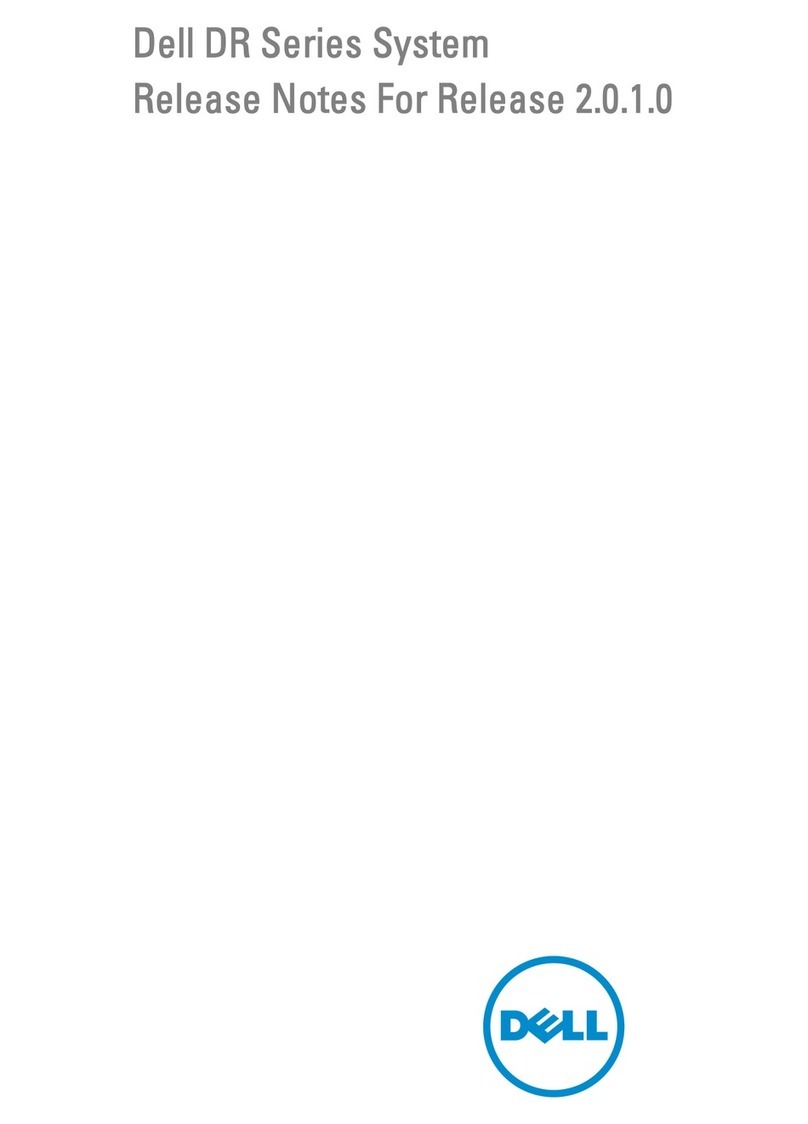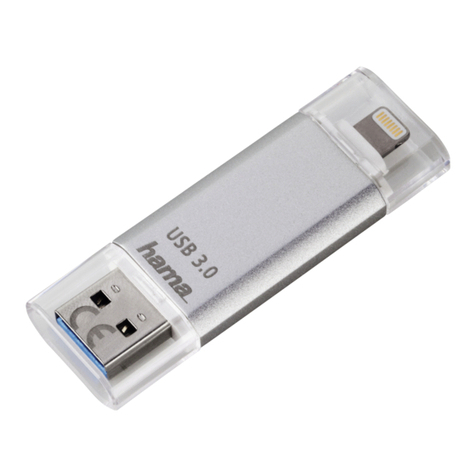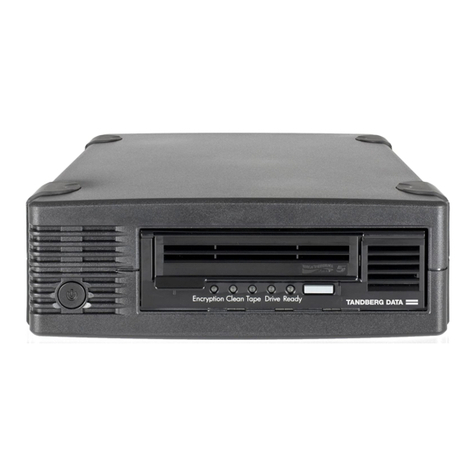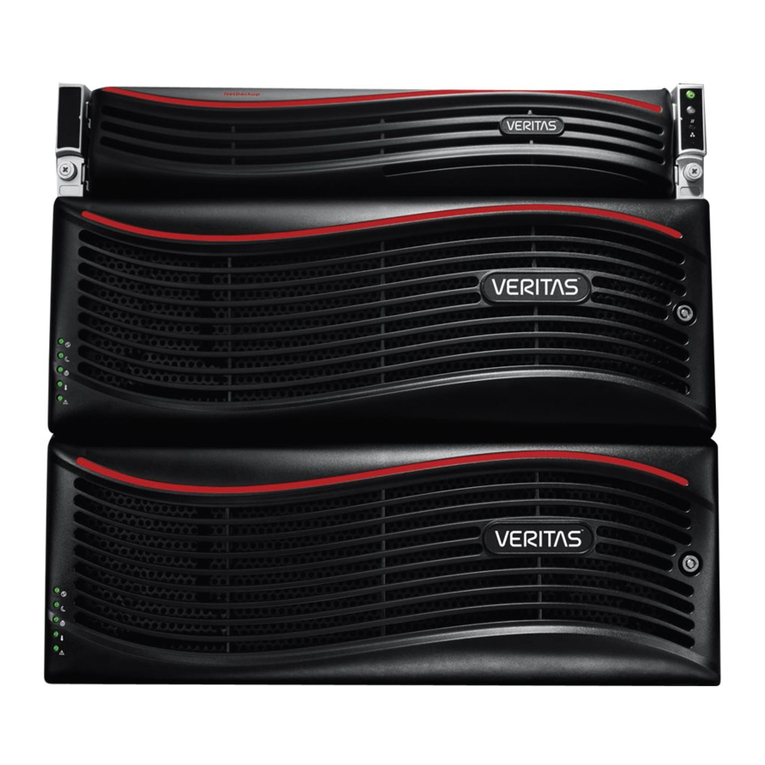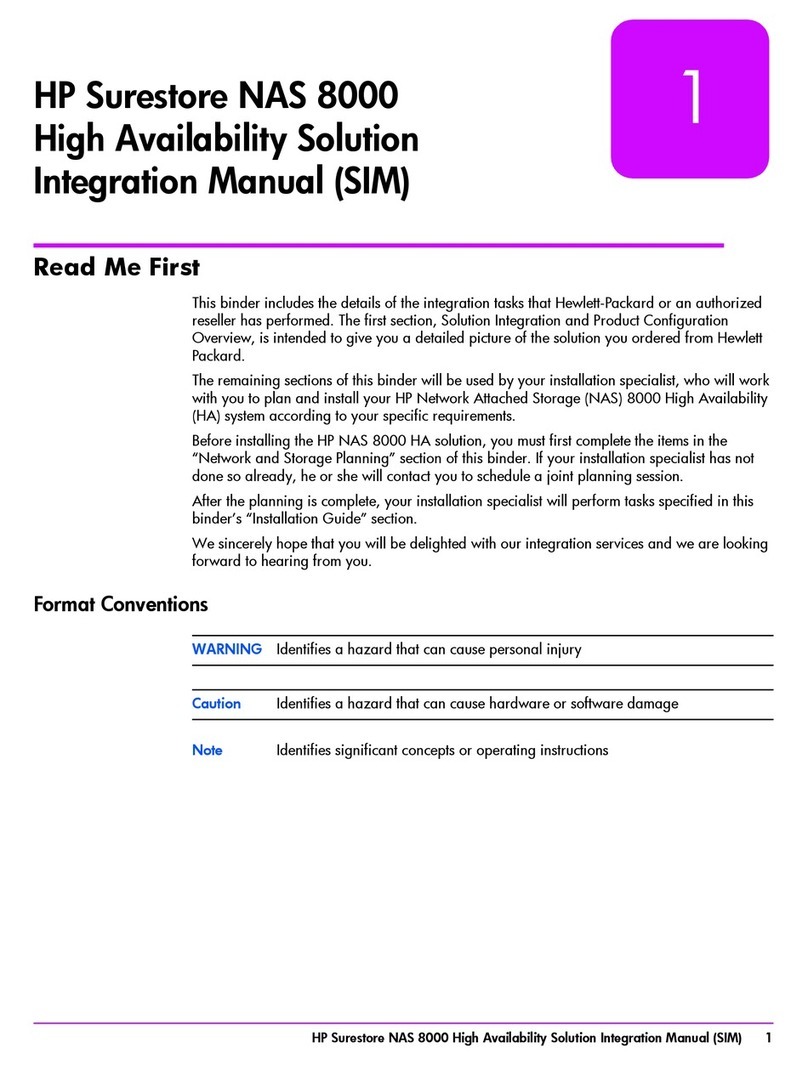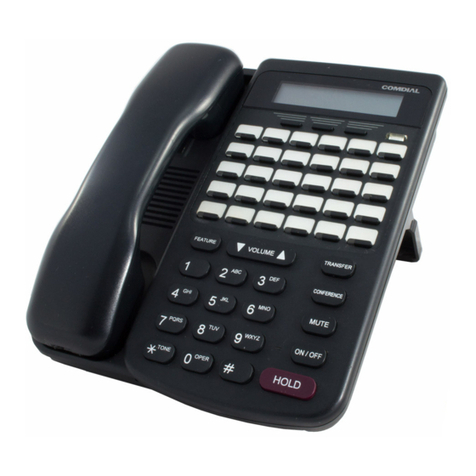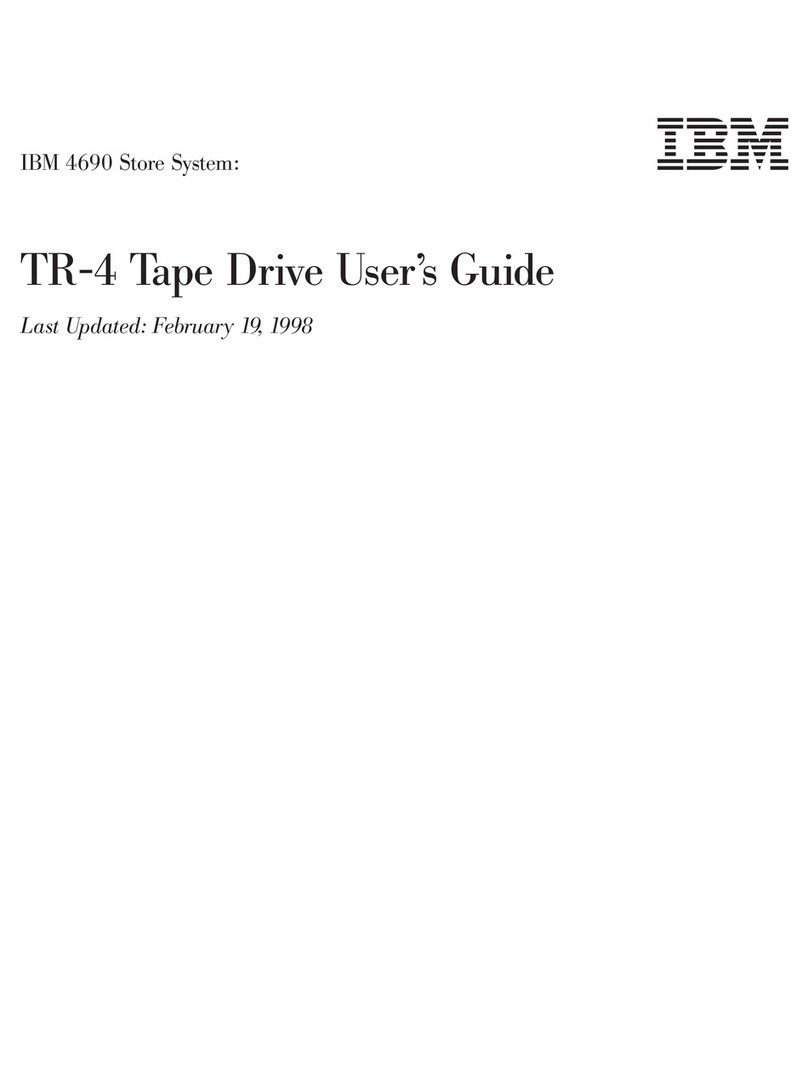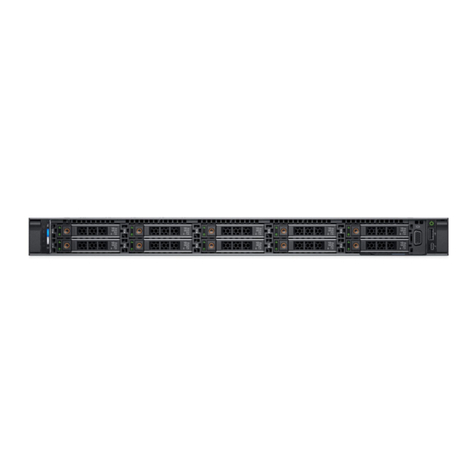HGST CinemaStar C5K1000.B Product manual

Technical Reference Manual
HGST Hard Disk Drive Technical Reference Manual
1
HCC541010B9E360
HGST CinemaStarTM C5K1000.B

HGST Hard Disk Drive Technical Reference Manual
2
Revision 1.0 (November 18, 2016)
Revision 1.1 (June 13,2017)
Revision 1.2 (June 29, 2017)
One MB is equal to one million bytes, one GB is equal to one billion bytes and one TB
equals 1,000GB (one trillion bytes) when referring to storage capacity. Accessible
capacity will vary from the stated capacity due to formatting and partitioning of the
drive, the computer’s operating system, and other factors.
The following paragraph does not apply to any jurisdiction where such provisions are
inconsistent with local law: THIS PUBLICATION IS PROVIDED "AS IS"WITHOUT
WARRANTY OF ANY KIND, EITHER EXPRESS OR IMPLIED, INCLUDING, BUT
NOT LIMITED TO, THE IMPLIED WARRANTIES OF MERCHANTABILITY OR
FITNESS FOR A PARTICULAR PURPOSE.
This publication could include technical inaccuracies or typographical errors.
Changes are periodically made to the information herein; these changes will be incor-
porated in new editions of the publication. There may be improvements or changes in
any products or programs described in this publication at any time. It is possible that
this publication may contain reference to, or information about, HGST products
(machines and programs), programming, or services that are not announced in your
country. Such references or information must not be construed to mean that Western
Digital Corporation intends to announce such HGST products, programming, or ser-
vices in your country. Technical information about this product is available by con-
tacting your local HGST product representative or on the Internet at:
support.hgst.com.
Western Digital Corporation may have patents or pending patent applications cover-
ing subject matter in this document. The furnishing of this document does not give you
any license to these patents.
© 2017Western Digital Corporation or its affiliates.
Western Digital, the HGST logo, CacheFlow, CinemaStar, Data Lifeguard
and SilkStream logo are registered trademarks or trade-marks of Western
Digital Corporation or its affiliates in the US and/or other countries. All other
trademarks are the property of their respective owners.
References in this publication to HGST-branded products, programs, or services do
not imply that they will be made available in all countries. Product specifications pro-
vided are sample specifications and do not constitute a warranty. Actual specifications
for unique part numbers may vary. Please visit the Support section of our website, sup-
port.hgst.com, for additional information on product specifications. Pictures shown
may vary from actual products.

HGST Hard Disk Drive Technical Reference Manual
3
HGST CinemaStar C5K1000.B
Technical Reference Manual

HGST Hard Disk Drive Technical Reference Manual
4

HGST Hard Disk Drive Technical Reference Manual
5
TABLE OF CONTENTS
1. DESCRIPTION AND FEATURES ...............................................................................................
1.1General Description.....................................................................................................
1.2Product Features..........................................................................................................
2. SPECIFICATIONS ......................................................................................................................
2.1Performance Specifications........................................................................................
2.2Physical Specifications................................................................................................
2.2.1 Physical Dimensions..........................................................................................
2.3Mechanical Specifications..........................................................................................
2.4Electrical Specifications..............................................................................................
2.4.1 Current Requirements and Power Dissipation....................................................
2.4.2 Typical +5V Current Draw During Spinup ..........................................................
2.4.3 Input Voltage Requirements ............................................................................................... 16
2.4.4 Ripple................................................................................................................
2.4.5 ESD....................................................................................................................
2.5Environmental Specifications.....................................................................................
2.5.1 Shock and Vibration...........................................................................................
2.5.2 Temperature and Humidity................................................................................
2.5.3 Thermocouple Location..................................................................................... 1
2.5.4 Cooling............................................................................................................. 1
2.5.5 Atmospheric Pressure........................................................................................ 1
2.5.6 Acoustics........................................................................................................... 1
2.5.7 RoHS (Restriction of Hazardous Substances)...................................................... 1
2.6Reliability Specification and Characteristics................................................................ 1
2.6.1 Average AFR Spectrum........................................................................................................20
2.7Device Plug Connector Pin Definitions.......................................................................
2.8Agency Approvals......................................................................................................
2.9Full Model Number Specification................................................................................
3. PRODUCT FEATURES .............................................................................................................
3.1SATA 3 Gb/s...................................................................................
3.2ATA-7 Streaming.......................................................................................................
3.3SilkStream.................................................................................................................
3.4Dynamic Fly Height Control.......................................................................................
3.5Advanced Format Technology....................................................................................
3.6Perpendicular Magnetic Recording (PMR)...................................................................
3.7Reduced Power Spinup (RPS)......................................................................................
3.8System-on-Chip (SOC)................................................................................................
3.9S.M.A.R.T. Command Transport (SCT)........................................................................
3.9.1 Write Same........................................................................................................
3.9.2 Temperature Reporting......................................................................................
3.10Reliability Features Set.............................................................................................
3.10.1 Data Lifeguard™..............................................................................................
3.10.2 Thermal Management......................................................................................
3.10.3 Internal Environmental Protection System........................................................
3.10.4 Recoverable Errors...........................................................................................
3.10.5 Unrecoverable Errors....................................................................................... 2

HGST Hard Disk Drive Technical Reference Manual
6
3.10.6 Self Test.......................................................................................................... 2
3.10.7 ATA Error Logging........................................................................................... 2
3.10.8 Defect Management......................................................................................... 2
3.11Automatic Defect Retirement.................................................................................... 2
3.11.1 Error Recovery Process..................................................................................... 2
3.12Hot Plug Support...................................................................................................... 2
3.13Active LED Status...................................................................................................... 2
3.14Fluid Dynamic Bearings (FDB)...................................................................................
3.15Staggered Spinup and Activity Indication (SATA Power Pin 11)..................................
3.15.1 Staggered Spinup............................................................................................
3.15.2 Activity Indication............................................................................................
3.16CacheFlow™.............................................................................................................
3.16.1 Write Cache.....................................................................................................
3.16.2 Read Cache......................................................................................................
3.16.3 48-bit Logical Block Addressing (LBA)..............................................................
3.17Power Management..................................................................................................
3.18Self-Monitoring, Analysis, and Reporting Technology (S.M.A.R.T.).............................
3.19Security Mode..........................................................................................................
3.19.1 Master and User Passwords.............................................................................
3.19.2 Security Levels.................................................................................................
4. AT COMMAND SET ...............................................................................................................
4.1Host Interface Commands.........................................................................................
4.1.1 ATA-7/ATA-8 Commands...................................................................................
4.1.2 SATA Commands...............................................................................................
4.1.3 Obsolete Commands.........................................................................................
4.1.4 SCT Commands ...................................................................................................................35
4.2S.M.A.R.T. (B0h).........................................................................................................
4.2.1 Read Attribute Values Sub-Command.................................................................
4.2.2 Supported Attributes.............................................................................................................37
4.2.3 Read Log Sector...................................................................................................................38
4.2.4 Offline Data Collection..........................................................................................................39
4.3Identify Device (ECh).................................................................................................. 3
4.4Set Features (EFh) .....................................................................................................
5. INSTALLATION AND SETUP PROCEDURES ...........................................................................
5.1Unpacking.................................................................................................................
5.1.1 Handling Precautions.........................................................................................
5.1.2 Inspection of Shipping Container..........................................................................................48
5.1.3 Removal From Shipping Container..................................................................... 4
5.1.4 Removal From Static Shielding Bag.................................................................... 4
5.1.5 Moving Precautions........................................................................................... 4
5.2Mounting Restrictions................................................................................................ 4
5.2.1 Orientation........................................................................................................ 4
5.2.2 Screw Size Limitations....................................................................................... 4
5.2.3 Grounding......................................................................................................... 4
5.3Jumper Settings.........................................................................................................
6. MAINTENANCE .......................................................................................................................

HGST Hard Disk Drive Technical Reference Manual
8
LIST OF FIGURES
Figure 2-1 Mounting Dimensions ................................................................................................................................14
Figure 2-2 Drive Base Casting Thermocouple Location .............................................................................................18
Figure 2-3 Forced Airflow Direction ...........................................................................................................................18
Figure 2-4 AFR Spectrum............................................................................................................................................20
Figure 2-5 Standard Factory Connectors .....................................................................................................................21
Figure 5-1 Drive Handling Precautions .......................................................................................................................47
Figure 5-2 Hard Drive Removal From Static Shielding Bag.......................................................................................48
Figure 5-3 Grounding Diagram....................................................................................................................................49
Figure 5-4 Jumper Settings ..........................................................................................................................................50

HGST Hard Disk Drive Technical Reference Manual #
9
LIST OF TABLES
Table 2-1 Shock and Vibration ....................................................................................................................................16
Table 2-2 Device Pin Connector Pin Definitions.........................................................................................................21
Table 2-3 Full Model Number Description..................................................................................................................22
Table 4-1 ATA-7/ATA-8 Command Opcodes ............................................................................................................33
Table 4-2 SATA Command Opcodes ..........................................................................................................................34
Table 4-3 Obsolete Command Opcodes ......................................................................................................................34
Table 4-4 SCT Action Codes .......................................................................................................................................35
Table 4-5 Definitions for the 512 Bytes.......................................................................................................................35
Table 4-6 Log Address Definition ...............................................................................................................................38
Table 4-7 Identify Device Command...........................................................................................................................39

HGST Hard Disk Drive Technical Reference Manual
10
1.0 DESCRIPTION AND FEATURES
1.1 General Description
HGST CinemaStar SATA hard drives are specially engineered to offer cool quiet operation while
providing maximum reliability in 24x7 always-on environments. With support for up to five
simultaneous HD video streams, these drives are perfect for DVRs, set-top boxes and digital video
surveillance.
HGST’s rugged and reliable hard drives are designed and manufactured to the highest standards of
quality and reliability. Built to last, this SATA hard drive is made for years of cool-running, high-
performance operation around the clock. Before shipping, every drive undergoes over 200 rigorous
tests to ensure functionality and compatibility.
1.2 Product Features
Serial ATA (SATA) — Serial ATA (SATA) is the next generation bus interface for
2.5-inch hard drives. It is designed to replace Parallel ATA, and has many advantages
including increased transfer rate, improved signal integrity, enhanced data protection, and hot
plug support.
ATA-7 Streaming Commands— The industry standard ATA-7 streaming command set
enhances streaming performance in personal video recorders and other CE devices. HGST
drives compatible with ATA-7 streaming commands can handle multiple data streams without
degradation in video quality, and are optimal for AV storage applications.
SilkStream™– Optimized for smooth, continuous digital video playback of up to twelve
simultaneous HD streams. SilkStream is compatible with the ATA streaming command set so
CE customers can use standard streaming management and error recovery options.
Dynamic Fly Height Control —Designed to compensate for head/media separation changes
due to temperature and altitude. This feature adds video quality margins across temperature
and altitude changes.
Advanced Format Technology — Technology adopted by HGST and other drive
manufacturers to increase media format efficiencies, thus enabling larger drive capacities.
Perpendicular Magnetic Recording (PMR) — With PMR technology the magnetization of
each data bit is aligned vertically to the spinning disk, rather than longitudinally as has been
the case in hard drive technology for decades. This enables more data on a given disk than is
possible with conventional longitudinal recording, and provides a platform for future
expansion of hard drive densities.
Reduced Power Spinup (RPS) — This optimized start up feature specifically designed for the
external hard drive and Consumer Electronics (CE) market. Specific focus for RPS is to
minimize the duration and magnitude of the peak power consumption from the hard drive.
System-on-Chip - The System-on-Chip (SOC) is the foundation for HGST's next generation
electronics and firmware architecture. The native SATA SOC lowers component count by
integrating a hard disk controller, high performance processor, high speed execution SRAM,
and read channel in a 128-pin package.
S.M.A.R.T. Command Transport (SCT) — The SCT Command Transport feature set provides
a method for a host to send commands and data to a device and for a device to send data and
status to a host using log pages.

HGST Hard Disk Drive Technical Reference Manual
11
Reliability Features Set-Data Lifeguard™ — Representing HGST's ongoing commitment to
data protection, Data Lifeguard includes features that enhance the drive’s ability to prevent
data loss. Data Lifeguard data protection utilities include thermal management, an environ-
mental protection system, and embedded error detection and repair features that automatically
detect, isolate, and repair problem areas that may develop over the extended use of the hard
drive. With these enhanced data reliability features, the drive can perform more accurate mon-
itoring, error repair, and deliver exceptional data security.
Hot Plug Support — SATA supports hot plugging (also known as “hot swapping”), the ability
to swap out a failed hard drive without having to power down the system or reboot. This
capability contributes to both data availability and serviceability without any associated
downtime, making it a critical feature for extending SATA into enterprise applications.
Active LED Status — These drives support external LED requirements. It provides an activity
LED output which is ON during command execution and OFF otherwise.
Fluid Dynamic Bearings (FDB) — Bearing design that incorporates a layer of high-viscosity
lubricant instead of ball bearings in the hard drive spindle motor. As an alternative to
conventional ball bearing technology, FDB designs provide increased non-operational shock
resistance, speed control, and improved acoustics.
Staggered Spin-Up — Native SATA feature that allows the system to control whether the drive
will spin up immediately or wait until the interface is fully ready.
CacheFlow™ —This unique, multi-generation caching algorithm evaluates the way data is
read from and written to the drive and adapts “on-the-fly” to the optimum read and write
caching methods. CacheFlow minimizes disk seek operations and overheads due to rotational
latency. CacheFlow supports sequential and random write cache. With write cache and other
CacheFlow features, the user can cache both read and write data. The cache can hold multiple
writes and collectively write them to the hard drive.
48-bit Logical Block Addressing (LBA) — The drives support both 48-bit and 28-bit LBA and
CHS-based addressing. LBA is included in advanced BIOS and operating system device
drivers and ensures high capacity disk integration.
Power Management — The drives support the ATA and Serial ATA power management
command set, allowing the host to reduce the power consumption of the drive by issuing a
variety of power management commands.
Automatic Defect Retirement — If the drive detects a defective sector while reading, writing,
or performing offline data collection, it automatically relocates the sector without end-user
intervention.
Self-Monitoring, Analysis, and Reporting Technology (S.M.A.R.T.) — S.M.A.R.T. enables a
drive’s internal status to be monitored through diagnostic commands at the host level and
during offline activities. S.M.A.R.T. devices employ data analysis algorithms that are used to
predict the likelihood of some near-term degradation or fault conditions. When used with a
S.M.A.R.T. application, the drive can alert the host system of a negative reliability status
condition. The host system can then warn the user of the impending risk of data loss and
recommend an appropriate action.
ATA Security — The drives support the ATA Security Mode Feature set. The ATA Security
Mode feature set allows the user to create a device lock password that prevents unauthorized
hard disk access even if the drive is removed from the host computer. The correct password
must be supplied to the hard drive in order to access user data. Both the User and Master
Password features are supported, along with the High and Maximum security modes. The
Master Password Revision code is also supported.

HGST Hard Disk Drive Technical Reference Manual
12
2.0 SPECIFICATIONS
2.1 Performance Specifications
Average Seek1
- Read
- Write
12.0 ms average
16.0 ms average
Track-to-Track Seek 12.0 ms average
Full Stroke Seek 23 ms average
Index Pulse Period 11.1 ms (nominal)
Average Latency 5.56 ms
Rotational Speed 5400 RPM
Data Transfer Rate (maximum)2
- Buffer to Host
- Max buffer to disk
3 Gb/s (HCC541010B9E360)
44 MB/s maximum
Buffer Size 16 MB
Error Rate - Unrecoverable <1 in 1014 bits read
Spindle Start Time
- From Power-on to Drive Ready 3 3.5s average (SATA)
- From Power-on to Rotational Speed 4 2.0s average (SATA)
Spindle Stop Time 8s average
Load/Unload Cycles5600,000
1During continuous Seek, Read, or Write commands, an algorithm in the code will add latency as required to keep
the VCM motor from overheating. Seek performance will be impacted under this condition.
2 As used for storage capacity, one megabyte (MB) = one million bytes, one gigabyte (GB) = one billion bytes, and
one terabyte (TB) = one trillion bytes. Total accessible capacity varies depending on operating environment. As
used for buffer or cache, one megabyte (MB) = 1,048,576 bytes. As used for transfer rate or interface, megabyte
per second (MB/s) = one million bytes per second, and gigabit per second (Gb/s) = one billion bits per second.
Effective maximum SATA 3 Gb/s transfer rate calculated according to the Serial ATA specification published by
the SATA-IO organization as of the date of this specification sheet. Visit www.sata-io.org for details.
3Defined as the time from power-on to the setting of Drive Ready and Seek Complete including calibration.
4Defined as the time from power-on to when the full spindle rotational speed is reached.
5Controlled unload at ambient condition.

HGST Hard Disk Drive Technical Reference Manual
13
2.2 Physical Specifications
2.2.1 Physical Dimensions
Physical Specifications HCC541010B9E360
Capacity11,000,204MB
Interface SATA 3 Gb/s
Actuator Type Rotary Voice Coil
Number of Disks 2
Data Surfaces 4
Number of Heads 4
Physical bytes per sector 4096
Host bytes per sector 512
User Sectors per Drive 1,953,525,168
Servo Type Embedded
Recording Method LDPC Target
1 As used for storage capacity, one megabyte (MB) = one million bytes, one gigabyte
(GB) = one billion bytes, and one terabyte (TB) = one trillion bytes. Total accessible
capacity varies depending on operating environment. As used for buffer or cache, one
megabyte (MB) = 1,048,576 bytes. As used for transfer rate or interface, megabyte
per second (MB/s) = one million bytes per second, and gigabit per second (Gb/s) = one
billion bits per second. Effective maximum SATA 3 Gb/s transfer rate calculated
according to the Serial ATA specification published by the SATA-IO organization as
of the date of this specification sheet. Visit www.sata-io.org for details.
English Metric
Dimension Tolerance Dimension Tolerance
Height 0.374 inches ±0.01 inch 9.50 mm ±0.20 mm
Length 3.94 inches ±0.01 inch 100.20 mm ±0.25 mm
Width 2.75 inches ±0.01 inch 69.85 mm ±0.25 mm
Weight
(typical) 0.25 pounds — 115 g —

HGST Hard Disk Drive Technical Reference Manual
14
2.3 Mechanical Specifications
Figure 2-1 shows the mounting dimensions and locations of the screw holes for the drive.
Figure 2-1. Mounting Dimensions

HGST Hard Disk Drive Technical Reference Manual
15
2.4 Electrical Specifications
2.4.1 Current Requirements and Power Dissipation
2.4.2 Typical +5V Current Draw During Spinup
Operating Mode Current1 Power1
5 VDC
Spinup (max) 1000 mA 5.0 W
Read/Write (average) 300 mA 1.5 W
Seek (average) 420 mA 2.1 W
POWER MANAGEMENT COMMANDS
Operating Mode Current1 2 Power1 2
5 VDC
Idle (E1H)(average) 270 mA 1.4 W
Standby (E0H)(average) 35 mA 0.18 W
Sleep (E6H)(average) 35 mA 0.18 W
1All values are typical (25°C and 5V input) except where specified as maximum.
2HGST power management values are based on the use of ATA and Serial ATA Power Management specification
for
HDD "Device Initiated Power Management (DIPM)". Per the ATA/SATA specification DIPM feature must be
supported and enabled by the HDD and the host.

HGST Hard Disk Drive Technical Reference Manual
16
2.4.3 Input Voltage Requirements
The input voltage requirement for these drives is +5.0V ± 5%.
2.4.4 Ripple
2.4.5 ESD
The ESD specification compliance is determined at room ambient conditions with nominal power
supply settings, unless otherwise specified.
2.5 Environmental Specifications
2.5.1 Shock and Vibration
Table 2-1. Shock and Vibration
Operating Vibration
Drives are tested by applying a random or swept sinusoidal excitation in each linear axis, one axis
at a time. The drive incurs no physical damage and no hard errors while operating and subjected to
continuous vibration not exceeding the level listed in Table 2-1. Operating performance may
degrade during periods of exposure to continuous vibration.
+5 VDC
Maximum
Frequency
100 mV (peak-to-peak)
10 KHz - 30 MHz
Op-System Level Minimum
Direct contact discharges 8 kV
Direct air discharges 15 kV
Indirect contact discharges (VCP & HCP) 8 kV
Indirect air discharges (VCP & HCP) 15 kV
Non-Op Drive Level
Direct contact discharges 8 kV
Direct air discharges 15 kV
Shock
Operating (2 ms) 400G
Non-operating (2 ms) 1000G
Note: Half-sine wave, measured without shock isolation and without non-recoverable errors.
Vibration
Operating10.063g2/Hz, 5 Hz-40 Hz; 0.063g2/Hz-0.0006g2/Hz, 40 Hz-500 Hz
Non-operating20.06984 g2/Hz, 10-500 Hz
Drive Generated Vibration
Operating (average) 0.25 gm-mm
Rotational Shock Non-Operating
Amplitude 50K rad/sec2
Duration 2 ms
12.2 Grms, measured using random write/read ratio of 1:3 at block size of 256.
25.8 Grms.

HGST Hard Disk Drive Technical Reference Manual
17
Non-Operating Vibration
Note: This specification applies to handling and transportation of unmounted drives.
Drives are tested by applying a random or swept sinusoidal excitation in each linear axis, one axis
at a time. The drive incurs no physical damage when subjected to continuous vibration not
exceeding the level listed in Table 2-1.
Drive Generated Vibration
Drives are tested by supporting a single drive horizontally in a free-free state and measuring the
side-to-side vibration. Self vibration may not exceed the level listed in Table 2-1.
Rotational Shock Non-Operating
Drives are tested by applying a rotational force centered around the actuator pivot. The drive incurs
no physical damage when subjected to the rotational force specified in Table 2-1.
Packaged Shock and Vibration
The shipping packaging is designed to meet the National/International Safe Transit Association
(N/ISTA) standards for packaged products. The drive incurs no physical damage when subjected to
the N/ISTA standards.
2.5.2 Temperature and Humidity
Operation
Min-Max Base Casting
Temperature1
Humidity
Thermal Gradient
Humidity Gradient
0°C to 65°C (32°F to 149°F)
8-90% RH non-condensing
29.4°C (maximum wet bulb)
20°C/hour (maximum)20%/
hour (maximum)
Non-Operation
Non-operating Temperature -40°C to 70°C (-40°F to 158°F)
Humidity
5-95% RH non-condensing
40C (maximum wet bulb)
Thermal Gradient 30C/hour (maximum)
Humidity Gradient 20%/hour (maximum)
1The system environment must allow sufficient air flow to limit maximum base casting tempertures as defined in
Figure 2-2 below..

HGST Hard Disk Drive Technical Reference Manual
18
2.5.3 Thermocouple Location
Figure 2-2. Drive Base Casting Thermocouple Location
2.5.4 Cooling
If forced air cooling is required, the drive must be positioned to receive airflow from one or more
fans as indicated in Figure 2-3.
Figure 2-3. Forced Airflow Direction
Component Location
Drive base casting See Figure 2-2
The system environment must allow sufficient air flow to limit maximum base casting temperatures
as defined in Figure 2-2 below.

HGST Hard Disk Drive Technical Reference Manual
19
2.5.5 Atmospheric Pressure
2.5.6 Acoustics
2.5.7 RoHS (Restriction of Hazardous Substances)
HGST hard drive products manufactured and sold worldwide after June 8, 2011, meet or exceed
Restriction of Hazardous Substances (RoHS) compliance requirements as mandated by the RoHS
Directive 2011/65/EU. RoHS aims to protect human health and the environment by restricting the
use of certain hazardous substances in new equipment, and consists of restrictions on lead,
mercury, cadmium, and other substances.
2.6 Reliability Specification and Characteristics
Altitude
Operating -1,000 feet to 10,000 feet (-305M to 3,048M)
Non-operating -1,000 feet to 40,000 feet (-305M to 12,192M)
TYPICAL SOUND POWER LEVEL1
Idle Mode (typical dBA) 224
Seek Mode (typical dBA) 325
1Measured per ECMA-74/ISO 7779.
2No audible pure tones.
3Random seek at a rate of 26 seeks per second.
The average Annualized Failure Rate (AFR) calculations assumeVWKHUHOLDELOLW\FKDUDFWHULVWLFV
EHORZ. Workload is defined as the number of bytes transferred by the user to/from the drive. If
the system(s) that the drive is installed in are not capable of meeting the characteristics listed
below, please use a +*67 drive that matches your system(s)' capability. Operating drives outside
any of the reliability characteristics listed below will result in a higher AFR.
Reliability Specification
Average AFR over the Limited Warranty Period 0.50%
Reliability Characteristics
Base Casting Temperature 40°C
Annual Power on Hours (POH) <=8760
Total Workload over the Limited Warranty Period <= 7%
This manual suits for next models
1
Table of contents
Other HGST Storage manuals
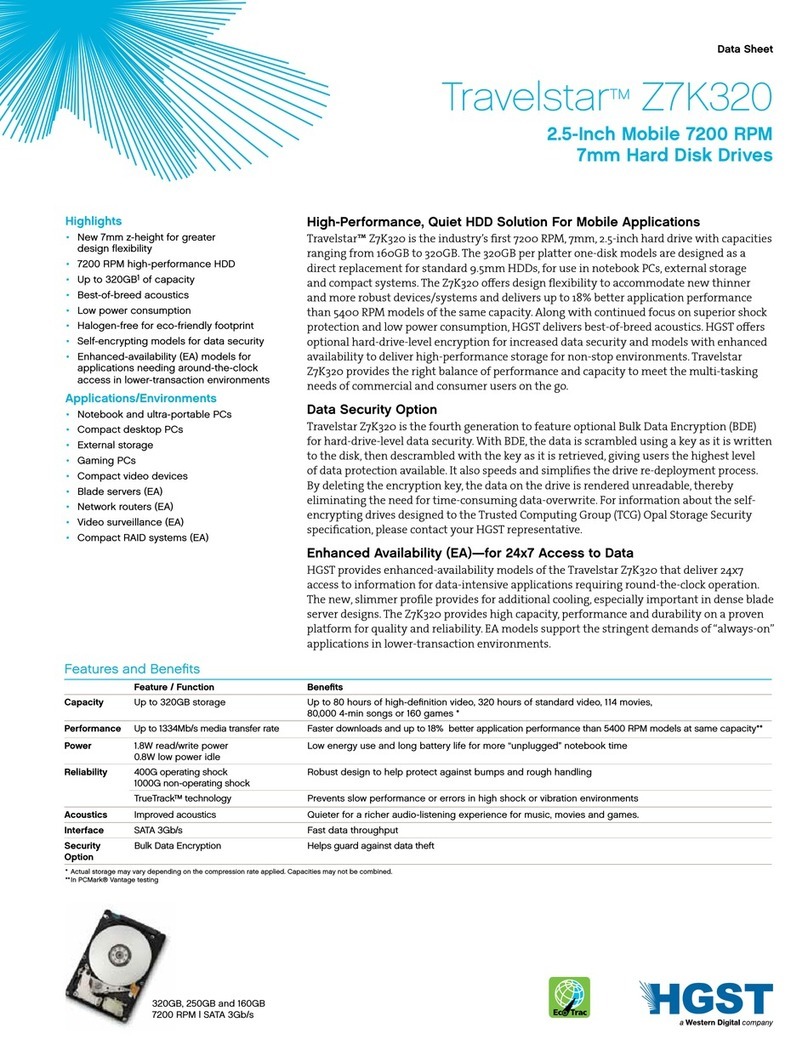
HGST
HGST Travelstar 2.5-Inch Mobile 7200 RPM 7mm... User manual
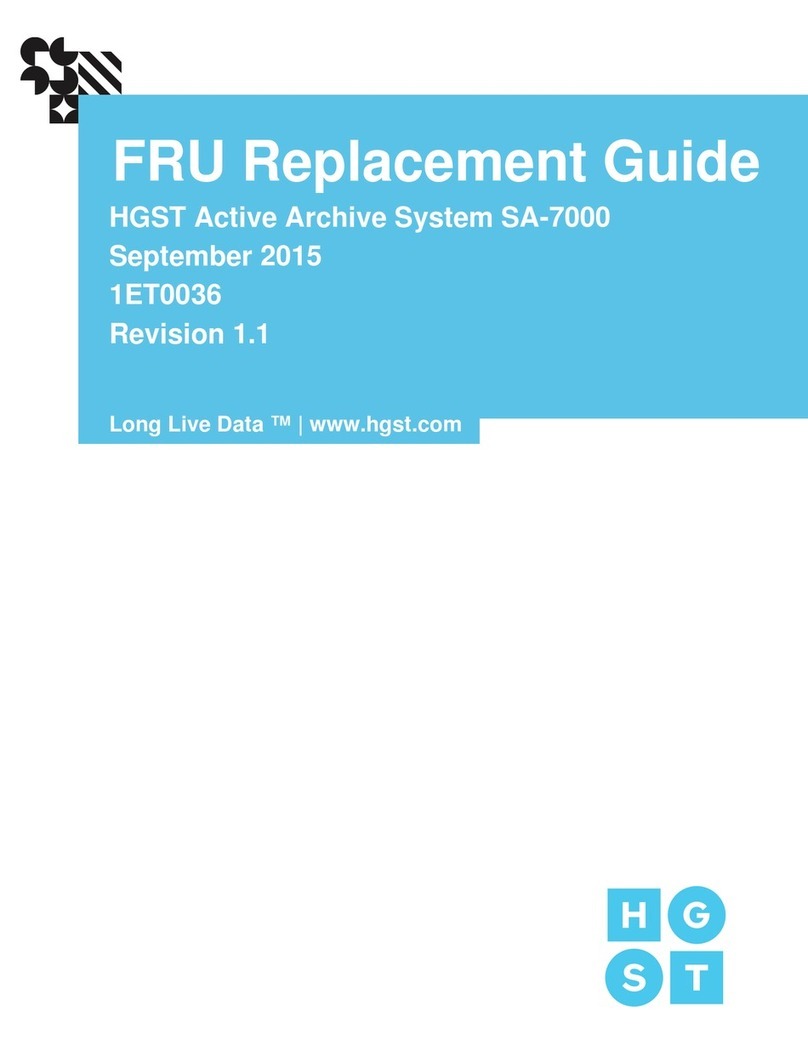
HGST
HGST SA-7000 Parts list manual
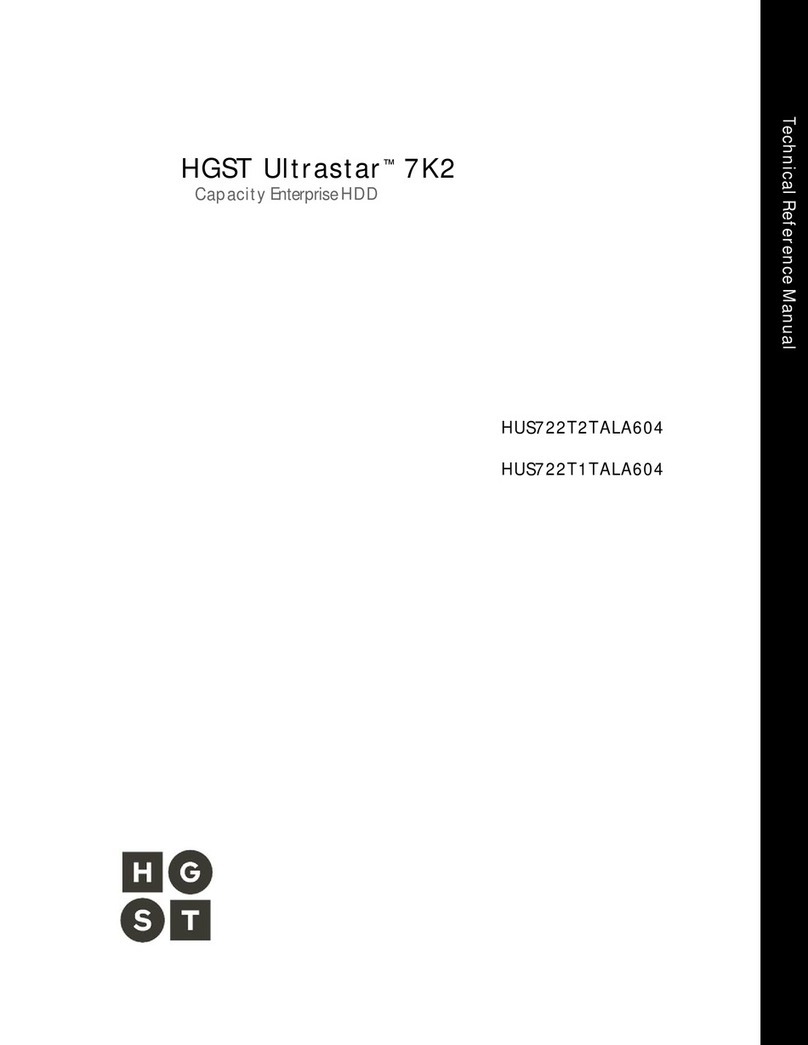
HGST
HGST Ultrastar 7K2 Product manual
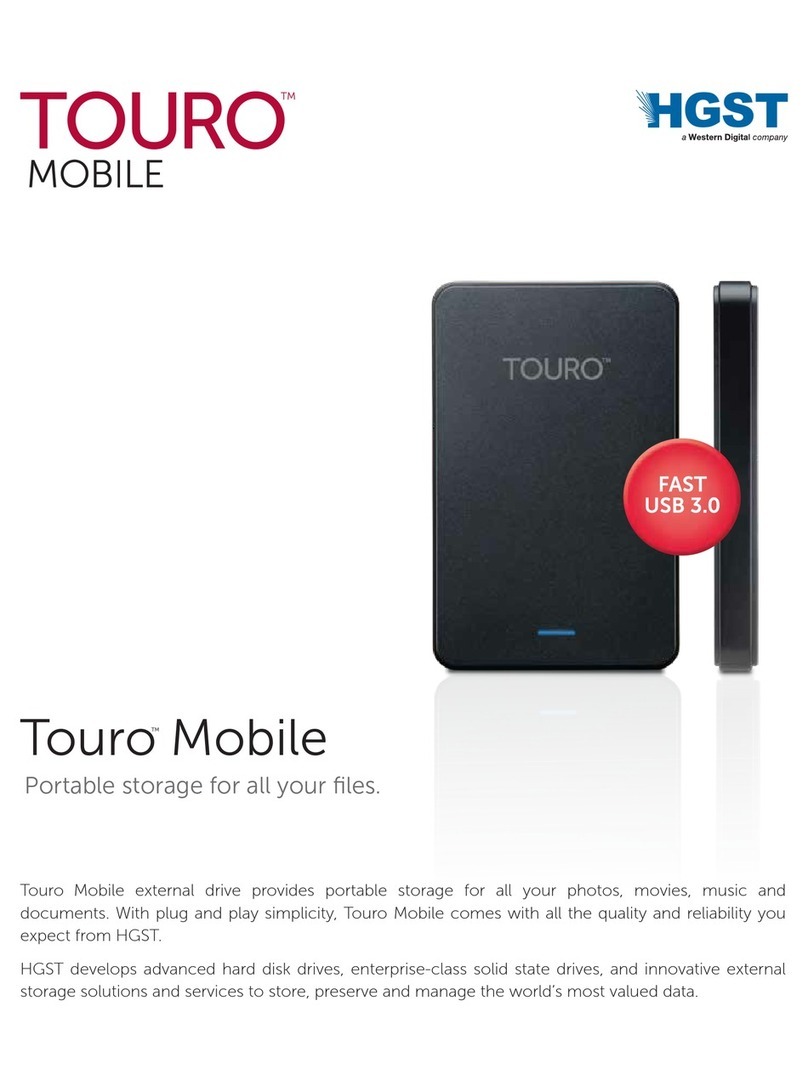
HGST
HGST Touro Mobile User manual

HGST
HGST HUS724040ALE640 User manual
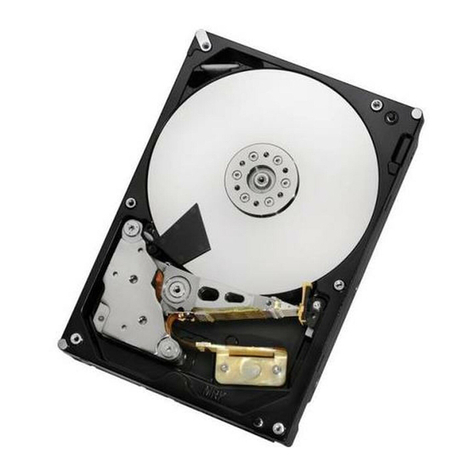
HGST
HGST HUS724040ALS640 User manual
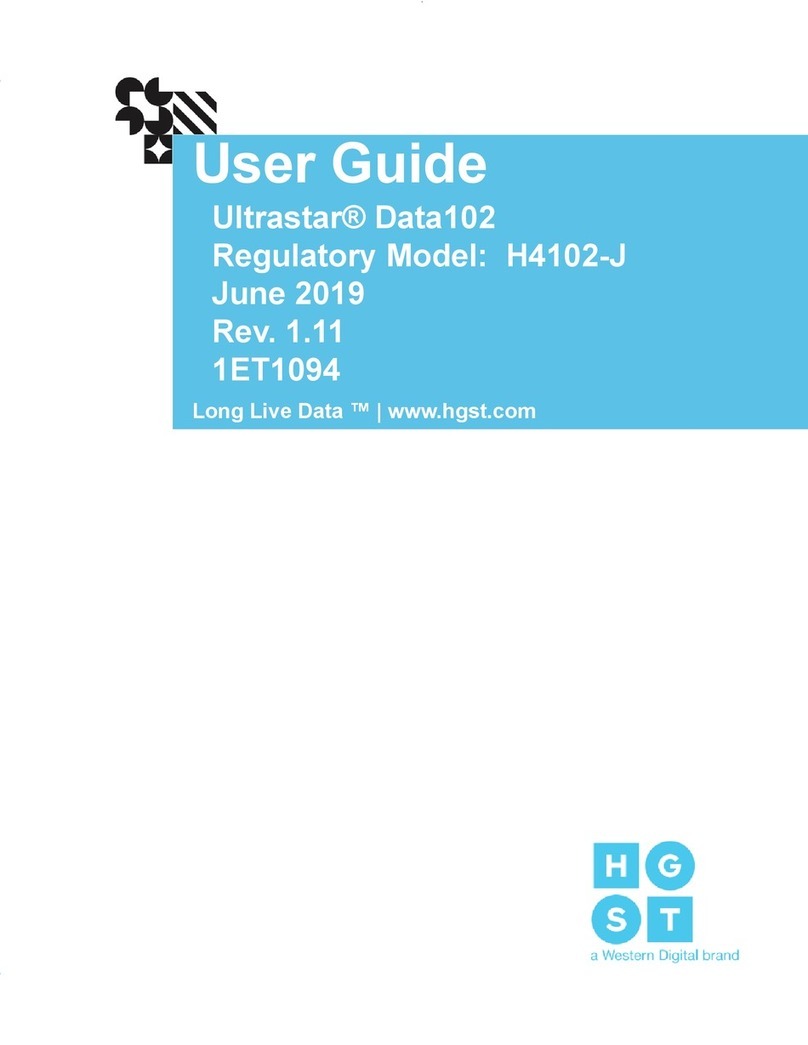
HGST
HGST Ultrastar Data102 User manual

HGST
HGST Travelstar Z5K500.B Product manual
Popular Storage manuals by other brands
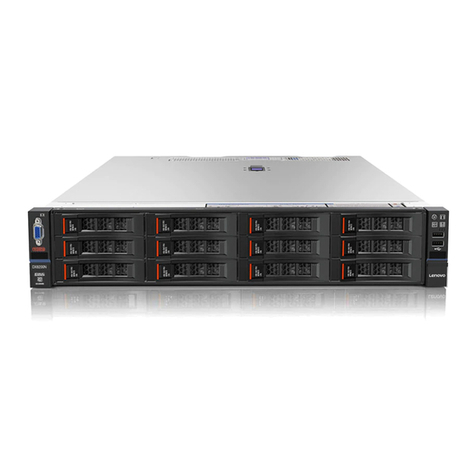
Lenovo
Lenovo DX8200N Serviceability Guide
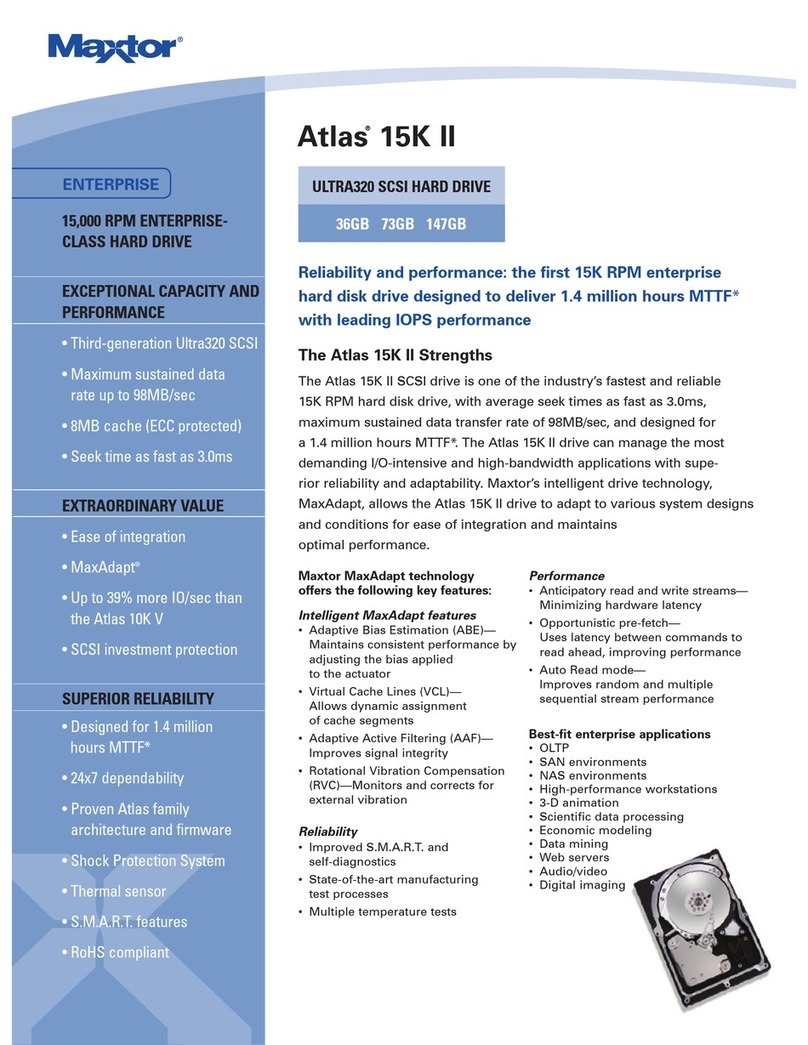
Maxtor
Maxtor Atlas SCSI Drive 15K II Specification sheet

Pixii
Pixii Power Base 600 installation guide
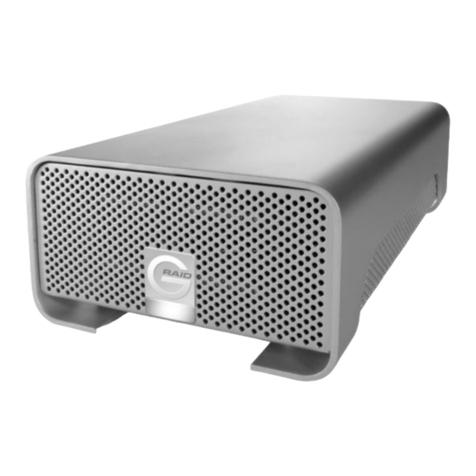
G-Technology
G-Technology G-RAID Studio install guide

FMD Furniture
FMD Furniture SCARPE 4 Assembly instructions

Thermo Scientific
Thermo Scientific Cryo 740 Series Operating and maintenance manual


